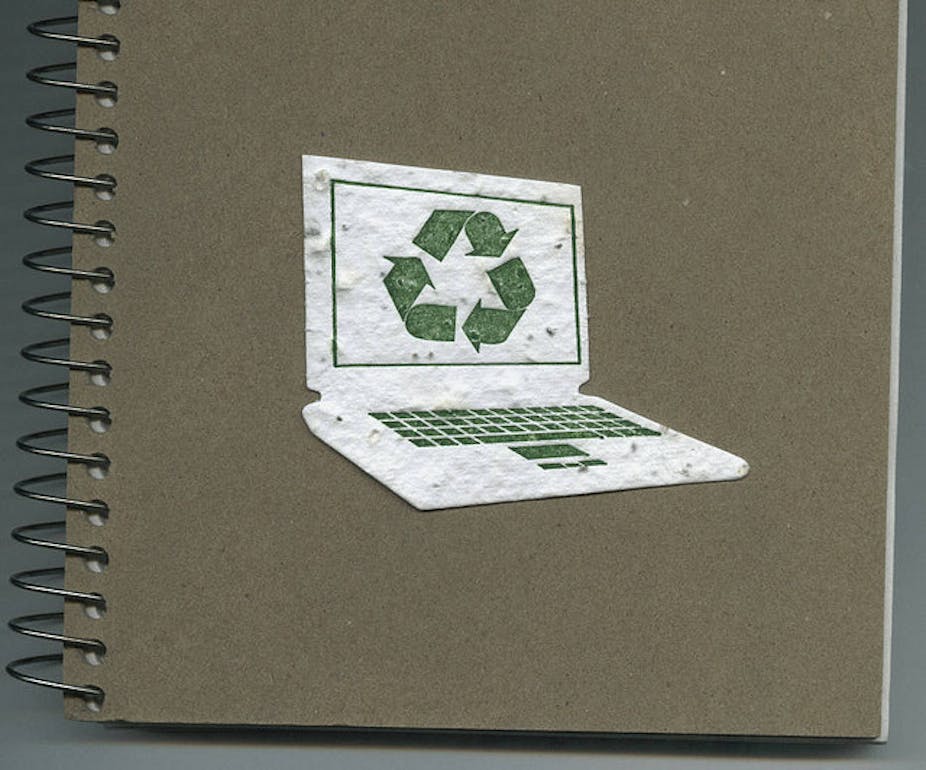For many years, individual consumers, industries and governments have all purchased printing and writing paper made with a high recycled-fibre content.
Why? Because they believe it is the most responsible and environmentally friendly thing to do. But is it really better for the environment?
Traditionally, fibre for paper and paper packaging comes from the wood of trees, with other sources of fibre – such as sugarcane and straw – making a minor contribution.
In more recent times, waste paper has also been used as a source of fibres. These recycled fibres are processed to make paper products similar to those made from original (virgin) wood fibres.
Paper used in stationery products is often a blend of virgin and recycled fibres. This is to maintain the brightness of the paper – virgin fibres produce whiter paper – while minimising environmental impacts. Manufacturers also tend to “remix” the blend depending on whether there is more recycled or virgin fibre available.
Products made from 100% recycled content are usually of a lower quality than those from virgin fibres. But 100% recycled products are still very suitable for most stationery applications.
White paper in; white paper out
Recycled paper is now everywhere in our lives. But recycling paper and then reusing the fibres is not always as simple as it might seem.

To manufacture recycled paper, the source paper needs to be white and similar in composition to what the recycled paper will be used for. For instance, if you’re going to make recycled paper for use in office photocopiers, you’ll need waste office paper to begin with.
Daily newspapers and weekly magazines are usually not suitable. Although they are white, their “whiteness” is often from clay powder coating, and the fibres themselves discolour readily.
(Newspapers are generally recycled to make newspapers. Cardboard is usually recycled into other “brown” products, including paper bags and corrugated cardboard.)
Where does the fibre come from?
To make recycled paper that is good enough to meet consumer demand, manufacturers have to collect and sort enough high-quality white paper.
In relatively low-population-density countries such as Australia this can be a costly exercise. (Driving bundles of waste paper between cities is expensive in a country this big).
But when the international price of virgin white fibre goes up – making non-recycled paper prohibitively expensive – it becomes more attractive to pay for the local collection and processing of waste white paper into recycled white fibre.
When you head to your local stationery store, the products you see on the shelves are made from both imported – usually from south-east Asia, east Asia or the Americas – and locally-made paper.

These products may be marketed as having various levels of recycled fibre content up to 100%. Any virgin fibre content is usually labelled as coming from certified, sustainable wood sources – selected native forests and plantations – rather than from tropical rainforests or old growth native forests.
This is because consumers are now demanding more sustainable, certified papers, and tend to avoid papers from old-growth forests.
(Certification of a paper’s origin is done by an independent authority such as the Forest Stewardship Council (FSC)).
Product and brand credibility would be at risk if a supplier chose to make incorrect claims about the paper they sold.
But of course, not all claims are entirely watertight. For example, tropical rainforest tree species have recently been identified in stationery papers imported into Australia.
But the provenance of paper is difficult for consumers to independently confirm, and can be difficult to prove even by experts with specialist laboratory analysis of the paper.
Better for the environment?
From an environmental-impact point of view, using products made from recycled fibre or virgin fibre is not an either/or proposition.
It makes sense to recycle paper (and use recycled-paper products) where possible, even though there are some environmental penalties involved in the production of recycled paper. These penalties can include the use of transport fuel used in the collection and transport of paper over long distances.

Also, we can’t keep recycling the paper we have now forever. Virgin fibres have to be introduced into the process at some point.
On average, a fibre can be recycled seven times before it is too degraded to make paper. Because of this fact, there has to be a supply of virgin wood fibres to maintain the supply and quality of fibres and, therefore, the paper.
Fortunately, the modern processes for extracting virgin fibres are biomass energy self-sufficient. When making stationary paper, the natural adhesive which binds the wood together (lignin) is dissolved from the wood then burnt to power the process. Any shortage in necessary energy can be generated by burning forestry waste such as tree bark.
These processes have minimal environmental impact, provided renewable and certified wood sources are used.
Stationery papers are only a part of the paper and paper packaging industry, but consumers can choose to buy quality goods with recycled fibre content, according to their preference for quality, environmental impact and cost.
Consumers should be aware that recycled paper can, but not always, have an environmental advantage and that they may be charged more for the privilege. The best protection is to buy paper produced entirely in Australia.
This article was written with the assistance of Dr Bruce Allender, Microscopist & Environmental Specialist at Covey Consulting.

